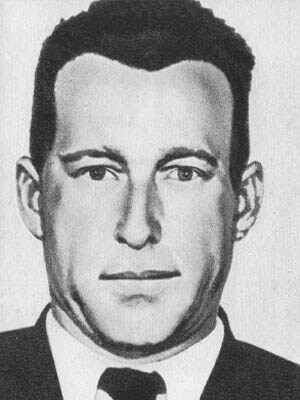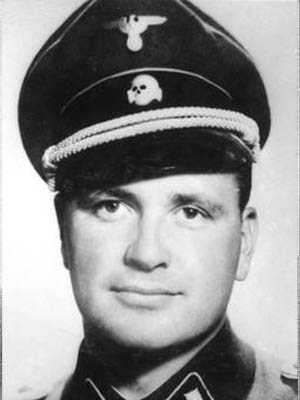Treblinka II - Nazi German extermination camp
Period of operation: 1942-1943
Place / City: Treblinka
Estimated number of victims: 800 000 - 1 000 000 *
* - According to estimates, 800,000 to 1,000,000 people were killed in Treblinka II camp. The victims were mainly Jews, about 760,000 came from Poland, but among the victims were Jews from Austria, Bulgaria, Belgium, Czechoslovakia, France, Greece, Yugoslavia, Germany and the USSR, as well as Roma and Sinti from Poland and Germany. Treblinka II was the largest extermination center in the General Government, and also the second one after Auschwitz-Birkenau in occupied Europe. The exact number of victims cannot be determined, but 800,000 victims are a certain number.
Commandants of the Treblinka extermination camp
Irmfried Eberl

Franz Stangl

Kurt Franz

Treblinka II was the main Nazi German extermination camp in the General Government. Next to Bełżec and Sobibór, it was the third extermination center created as part of Operation Reinhard. The camp was located near the village of Treblinka, about 80 km northeast of Warsaw, on the main railway line Warsaw-Białystok.
In December 1941, the Nazis opened the first camp in Treblinka at a distance of 4 km from the railway station, as a small forced labor camp. At the turn of May and June 1942, a second secret camp was built in Treblinka, called "T.II" (Treblinka II). The camp occupied an area of about 20 hectares of carefully camouflaged and isolated area, where several gas chambers were situated (powered by diesel engines), as well as camp buildings (residential barracks, warehouses, kitchen, etc.). The camp consisted of three zones: administrative and residential, a reception area and a death zone.
About 30-40 Germans and Austrians, as well as 100-120 guards, mainly of Ukrainian origin - SS Wachmannschaften, served in the camp.
After arriving in Treblinka II by rail freight cars, the victims were separated according to their sex, deprived of clothing and other property. They were directed to buildings which imitated bathhouses, located about 200 m from the reception area, which were actually gas chambers. People who could not reach the gas chambers on their own, as well as prisoners unable to work or sentenced to death for various offenses, were directed to the so-called "Lazaret", a place imitating a hospital, where they were shot.
The first commander of the camp was Irmfried Eberl, a veteran of the T4 campaign, who wanted to make Treblinka II a model extermination camp. Between July 23 and August 28, 1942, as many as 312.5 thousand Jews were estimated to be murdered in Treblinka II. Pits and hearth grates did not function then, and the gravedigger commandos composed of prisoners could not keep up with burying the corpses. During this period, 2-3 transports arrived at the camps per day. One transport consisted of about 60 freight cars, which were divided into fragments of 20. Such a number of prisoners was brought to the admission area, while the remaining part of the transport waited in a queue at the railway siding. Most likely, on August 6, 1942, about 200 children from the Warsaw orphanage were deported to Treblinka II, who, along with their guardian, Janusz Korczak (actually Henryk Goldszmit), as well as other employees of the orphanage, were murdered in gas chambers.
Due to the chaos prevailing in Treblinka, as well as the unimaginable smell of decaying corpses, perceptible for many kilometers, which made it impossible to keep the existence of the extermination camp secret, and also because of the lack of expected supplies of gold and other goods, Odilo Globocnik, together with the inspector of the extermination camps, Christian Wirth, and his assistant, professor Josef Oberhauser, personally went to the Treblinka II extermination camp for an inspection.
Irmfried Eberl was dismissed from the position of commander, and his place was taken by SS-Obersturmführer Franz Stangl who, as an experienced officer from Sobibor, reorganized the camp. As a result, the extermination process was significantly improved. New, more "efficient" gas chambers were built (based on the model of chambers from Bełżec and Sobibor), whose construction was supervised by Lorenz Hackenholt, known as the “gas master”. As part of the reorganization of the camp, a wooden imitation of a railway station was also built to confuse and disorganize the people arriving there.
In February 1943, a decision was made to exhume mass graves. From spring 1943, the traces of crimes were blurred. Commandos of prisoners dug up the bodies of the murdered and burned them on special grates made of rails.
On August 2, 1943, a group of Jewish prisoners began a rebellion involving over 800 prisoners. The prisoners set fire to part of the camp buildings. However, they failed to destroy the gas chambers. Only a small part of the insurgents had weapons and ammunition which they carried out of the SS armory. The remaining prisoners of the camp were armed only with axes, knives and rods. The rebellion did not end with the planned success. About 200 prisoners managed to escape, while within a few days almost half of them were captured and killed. Less than 100 escaped prisoners survived the war and became the few witnesses of mass murders in Treblinka.
On August 23, the last transports of Jews from the Białystok ghetto arrived, who were killed. Then the deportation was stopped and the traces of crime were liquidated and erased. The action was supervised by the last commandant of Treblinka, Kurt Franz. The whole camp was liquidated, and the places where human ashes were buried were plowed and covered with a layer of soil from a nearby gravel pit. The camp bakery became a house, which was modeled as a farm, and the camp area was planted with lupine. In July 1944, just before the arrival of the Red Army, the house was burned down, and the Ukrainian family who lived in it fled, heading for Warsaw.
On August 6, 1944, a railwayman named Franciszek Ząbecki took some documents from the mined station building as evidence of crimes committed in Treblinka. These materials were later used in trials against German criminals.
After the war, very few people went to court. The most important trial in the Treblinka case took place in Düsseldorf in 1964–1965. Ten members of the German crew were trialed, including:
Kurt Hubert Franz - deputy of Franz Stangl who escaped from American captivity at the end of the war, and then lived under his name in Germany. After his arrest in 1959, he was sentenced to life imprisonment in the first trial in the Treblinka case. In 1993 he was released from prison for health reasons. He died in 1998 in a nursing home in Wuppertal.
Thanks to the testimonies of the survivors, the prosecution managed to convict nine of the accused, while Franz and three other SS men received life imprisonment sentences.
The "second trial of Treblinka's crew" also took place in Düsseldorf in 1970, and only the camp commandant Franz Stangl was trialed. After the war, he fled to Austria, where he was arrested by the US Army. However, he managed to escape to Syria, and then to South America. He was not detained until 1967 in São Paulo. The Stangl trial ended on October 22, 1970. He was found guilty of 900,000 deaths and died of a heart attack on June 28, 1971.
Fedor Fedorenko - He came from the Ukraine. During the war, he served in the Treblinka extermination camp. As a former Soviet citizen, he came to the United States on the basis of a DPA visa (1949). Fedorenko became a naturalized US citizen in 1970. He was caught in 1977 and denaturalized in 1981. Then, he was extradited to the USSR, where he was sentenced to death for treason of his nation and participation in the Holocaust. The sentence was carried out in July 1986
One of the executioners whose fate remains unknown was Ivan Ivanovich Marchenko, nicknamed "Ivan the Terrible" by the Jews (Ivan Grozny). His task was to direct Jews to the gas chambers. In 1943 he was transferred to Trieste, and in 1944 he fled to Yugoslavia.
Related Articles
- Irmfried Eberl - T4 and Operation Reinhardt member
- Treblinka, Bełżec, Sobibór: Gas Chambers And Their Commemoration
- Final liquidation of the Treblinka death camp
- Treblinka railway station
- Gas chambers in Germans death camps
- Deportation and death of Janusz Korczak
- Christian wirth was promoted to the position of inspector of extermination camps
- Treblinka I - German Nazi labor camp (1941-1944)
- Lorenz Hackenholt - "Gas Master"
- SS Wachmannschaften, torturers from the East - part 1
- SS Wachmannschaften, torturers from the East - part 2
- SS Wachmannschaften, torturers from the East - part 3
- Odilo Globocnik - Death Manager
- “Lazaret”, The Infirmary Of Death
- Franz Stangl - Commander Of Death Camps
- Exhaust gas chambers
Timeline
1942-07-22 - the first deportation of Jews from the Warsaw ghetto to Treblinka. The President of the Jewish Council, Adam Czerniakow, is informed about the beginning of "resettlement to the east".
1942-07-23 - the first transport with the "displaced" from Warsaw goes to the Treblinka extermination camp. Dr. Irmfried Eberl becomes the first commander of the extermination camp
1942-08-06 - Janusz Korczak and around 200 orphans of the Orphans' Home are sent to the Treblinka extermination camp.
1942-08-26 - Odilo Globocnik, Christian Wirth and Josef Oberhauser visit the Treblinka death camp. Irmfried Eberl is dismissed from the command office.
1942-09-01 - Franz Stangl officially becomes the second commander of the Treblinka extermination camp.
1943-02/03 - a special grate was built in the Treblinka II extermination camp, on which bodies were burnt to cover the traces of genocide. It was caused by, among others, overflow of mass graves and the discovery of mass graves in the Katyn forests.
1943-08-02 - outbreak of the uprising in Treblinka II camp. About 200 prisoners managed to get out of the camp. However, at most 100 people survived until the end of the war. The outbreak of the uprising suspended transports and murders in gas chambers for about a month.
1943-08-23 - the last transport of Jews to the extermination camp. There were Jews from Białystok.
1943-11-17 - liquidation of the Treblinka extermination camp. All camp buildings and installations were demolished. A farm was built for a Ukrainian family, and the camp area was plowed and planted with lupine.
1944-08-06 - a railwayman, Franciszek Ząbecki, takes documents confirming the crimes committed in the camp from the Treblinka railway station. The materials were used in trials against German torturers.
